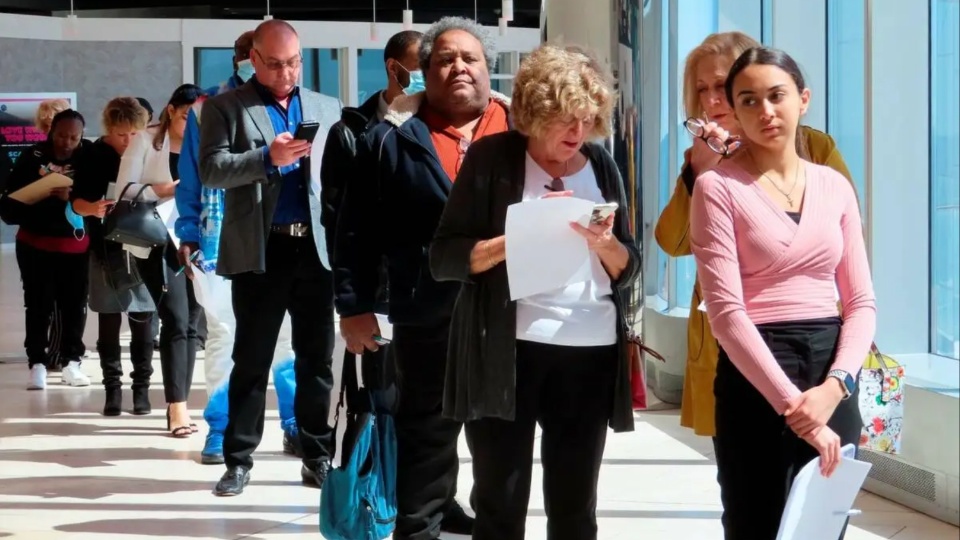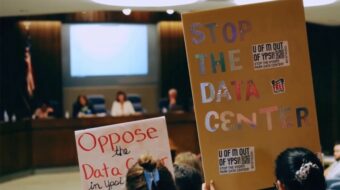
The season of mass layoffs appears to have no end in sight. Beginning late last year, the wave of layoffs that have primarily hit technology companies does not seem to be slowing down. More tech industry workers were laid off in 2022 than in the pandemic years of 2020 and 2021 combined, and for 2023, the number is already hovering around 200,000 eliminated jobs.
The layoffs have not spared other professional sectors, though, like retail, pharmaceuticals, finance, staffing, and broadcasting. Even the Los Angeles Times had to report on its own staff layoffs.
What is most striking is how many of these companies are, in fact, still hiring new employees while laying off others—a common practice that is sometimes used to cull lower performing employees when laying off en masse.
Although some companies are experiencing hiring freezes in order to reduce costs—or to replace positions with ChatGPT—many continue to onboard new employees; others have turned to replacing permanent positions with contract roles.
It is technically legal to hire new employees, even during layoffs; however, it is not legal to hire people into roles from which previous employees were laid off. Yet this still does not seem to make sense: How is a company able to bring aboard new people while needing to lay off others to free up cash flow?
There are a number of possible scenarios for how and why this happens. Sometimes, the salary and benefits of new positions might have already been approved for the budget. Or they could be roles in departments unaffected by a layoff. In other cases, new positions are opened up by the elimination of middle management roles. And sometimes, only the title itself is new even if no new staff were added.
However, none of these fully explains why layoffs and hiring often happen at the same time in the same company.
There is another factor to consider here.
Layoffs have a negative effect on the employees retained, often pushing some to quit as a result. Layoffs and resignations both have a contagion-like effect, so much so that companies often expect an extra 7 to 8% of employees to leave in the wake of a mass layoff.
Layoffs—or “reductions in force” as they are referred to in severance agreements—are viewed as a way of freeing up overhead costs or getting the budget back into the black or resolving a lack of cash flow—i.e., making the company profitable again. Along these same lines, a layoff would seem like an attempt to create a thinner, more efficient workforce to allow the finances to return to a place of stability.
Yet, if companies can also expect an extra 7 to 8% of their workforce to leave, do layoffs not put these expectations in jeopardy? Do layoffs not create more uncertainty for the company and its ability to function in a way that allows business to continue?
While the standard views of layoffs are true to some degree, layoffs can also act as a means of reasserting control. This is clear from two trends: 1) Salaries, already viewed by many as “inflated,” are being driven downward; and 2) Benefits like working remotely are being called into question entirely.
Although cutting salaries and benefits can—and often does—happen outright and without justification, companies usually try to come up reason to tamp down anger and help sell their decision to chop paychecks and perks.
A change in available health plans is common enough that many don’t question it after a company restructures and lays off its employees, for instance, but removing a benefit entirely takes a bit more work to keep workers pacified.
Focusing on remote work can help us understand how far this ideology-at-work goes.
A Pew Research survey found that 56% of people claim that working remotely helps them get their work done on time, while only 7% say it negatively impacts their work. There also exists a seemingly endless amount of articles on the benefits of remote work for employees and employers alike. So, what is so bad about remote work?
OpenAI CEO Sam Altman recently claimed that the remote work “experiment” was a mistake and is now over. James Clark, of the digital marketing company Clearlink, has voiced his blunter worries that workers may be “secretly working multiple jobs” or even using tools like ChatGPT to free up “time that his company isn’t utilizing.”
IBM CEO Arvind Krishna argues that career growth suffers when people are not working together in offices, despite the fact that IBM cut 7,800 jobs in favor of using AI tools instead.
One study on remote work published in Nature in 2021 claimed that collaboration is what’s at stake when employees are not working in a centralized location, suggesting communication is asynchronous and knowledge tends to get siloed instead of being shared.
These concerns are at the very heart of both Altman’s epitaph and Krishna’s analysis on remote work as well, however they differ ever so slightly. Altman argues that innovation comes from being in an office together, while Krishna warns of the consequences of remaining remote, suggesting a more compulsive type of collaboration.
What should not be missed here is how, in such a short time, capitalism’s old ideological claim that “competition breeds innovation” has been replaced with “collaboration breeds innovation.” This is interesting because—in the face of overwhelming workloads, unattainable deadlines, and constant changes in the industry—collaborative work has been the demand of tech workers for decades.
Perhaps it’s more accurate to say that the claim “competition breeds innovation” is no longer deployed by ruling class ideologues now that they can use the notion of collaboration against workers to take away a benefit like remote working and reassert their control of employees’ time.
It’s important that we take writer/activist Tariq Ali’s assessment of such headlines and quotes seriously and not fall into the trap of being “a country that mistakes media sound bites for history.” The Nature study on remote work does, in fact, acknowledge its limitations, but it’s worth noting that not only was the study itself too early—being conducted six months into the 2020 lockdown—it also only focused on Microsoft and its employees.
As for the concerns of asynchronous communication and siloed knowledge: The former is a social problem that has existed well before capitalism and is something that technology has attempted to solve through instant messaging and email; the latter is a problem of management. Neither of these symptoms is unique to remote work nor the tech industry.
Another aspect to consider is how, although middle management positions such as team leads, directors, product managers, etc., tend to be eliminated during layoffs, these positions also tend to proliferate again after companies go through reorganization following a layoff.
This might sound like good news for workers spared by layoffs, but in many cases, the result is either more work for the remaining middle managers, who end up taking on more departments and projects, or—and this is the rub—there are actually more rungs on the ladder between a regular employee and a management position.
As one person who works for a U.S.-based designer clothing company told People’s World, “After the last round of layoffs, there are now six roles between my boss and me. Before the layoffs, there were only four.”
Another way this can play out is the removal of middle managers altogether, which, in effect, means workers are not likely at all to move up the corporate ladder. For example, by removing a director or vice-level position, it may theoretically bring an employee closer to the C-level role, but is far less likely that the employee will ever be promoted to that level. The ocean between a boss and workers only grows as the two get closer.
It is worth noting here that this does turn the old notion of a dead-end job on its head: It is no longer just the person at the bottom who is stuck in a dead-end job, but rather the people ascending and already near—but not yet at—the top who come to the end of their road.
It’s hard to imagine that only recently we were being told that “no one wants to work anymore” and yet, today, we all have the potential of having our work taken away from us. We have not heard the last of the “no one wants to work anymore” argument, and it will return again, as it often does whenever some business-oriented politician wants to cut unemployment benefits or other social services.
However, this ideology exposes its own inherent weakness: The frequency with which the argument returns bears witness to the modicum of truth within it. It’s true, nobody wants to work anymore—for less than they’re worth. Nobody wants to risk their life for their job, and nobody wants to be subjected to sexual harassment and racist hostility at work.
So, with the right addendums, the argument’s appearance can be made to work in our favor.
For up-to-date information on which companies have laid off workers and how many, check the layoff tracker here.
We hope you appreciated this article. At People’s World, we believe news and information should be free and accessible to all, but we need your help. Our journalism is free of corporate influence and paywalls because we are totally reader-supported. Only you, our readers and supporters, make this possible. If you enjoy reading People’s World and the stories we bring you, please support our work by donating or becoming a monthly sustainer today. Thank you!










